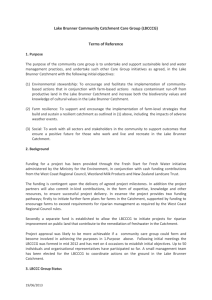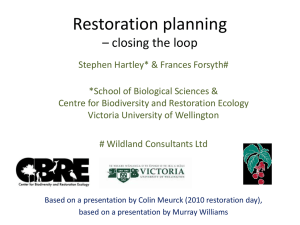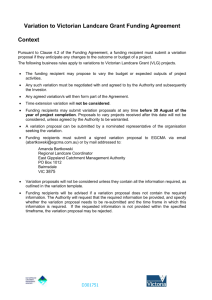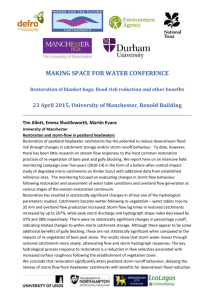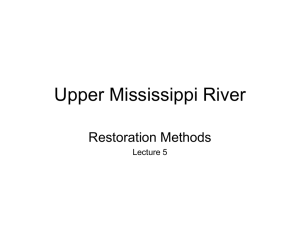RRR15_KrisBoody_Paper - Reef Range & Red Dust 2015
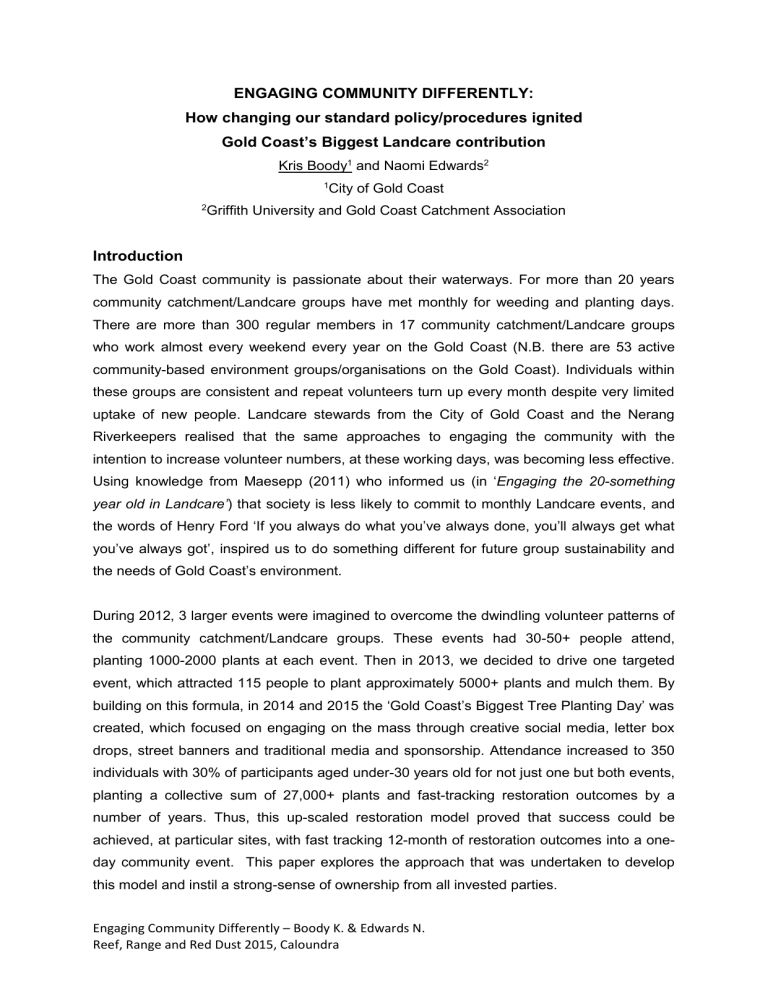
ENGAGING COMMUNITY DIFFERENTLY:
How changing our standard policy/procedures ignited
Gold Coast’s Biggest Landcare contribution
Kris Boody 1 and Naomi Edwards 2
1 City of Gold Coast
2 Griffith University and Gold Coast Catchment Association
Introduction
The Gold Coast community is passionate about their waterways. For more than 20 years community catchment/Landcare groups have met monthly for weeding and planting days.
There are more than 300 regular members in 17 community catchment/Landcare groups who work almost every weekend every year on the Gold Coast (N.B. there are 53 active community-based environment groups/organisations on the Gold Coast). Individuals within these groups are consistent and repeat volunteers turn up every month despite very limited uptake of new people. Landcare stewards from the City of Gold Coast and the Nerang
Riverkeepers realised that the same approaches to engaging the community with the intention to increase volunteer numbers, at these working days, was becoming less effective.
Using knowledge from Maesepp (2011) who informed us ( in ‘
Engaging the 20-something year old in Landcare’ ) that society is less likely to commit to monthly Landcare events, and the words of Henry Ford ‘If you always do what you’ve always done, you’ll always get what you’ve always got’, inspired us to do something different for future group sustainability and the needs of
Gold Coast’s environment.
During 2012, 3 larger events were imagined to overcome the dwindling volunteer patterns of the community catchment/Landcare groups. These events had 30-50+ people attend, planting 1000-2000 plants at each event. Then in 2013, we decided to drive one targeted event, which attracted 115 people to plant approximately 5000+ plants and mulch them. By building on th is formula, in 2014 and 2015 the ‘Gold Coast’s Biggest Tree Planting Day’ was created, which focused on engaging on the mass through creative social media, letter box drops, street banners and traditional media and sponsorship. Attendance increased to 350 individuals with 30% of participants aged under-30 years old for not just one but both events, planting a collective sum of 27,000+ plants and fast-tracking restoration outcomes by a number of years. Thus, this up-scaled restoration model proved that success could be achieved, at particular sites, with fast tracking 12-month of restoration outcomes into a oneday community event. This paper explores the approach that was undertaken to develop this model and instil a strong-sense of ownership from all invested parties.
Engaging Community Differently – Boody K. & Edwards N.
Reef, Range and Red Dust 2015, Caloundra
New ways of doing community-based catchment management:
Historically, the Gold Coast has had ongoing community-based bush, creek, coastal and ocean care groups and organisations that either work in partnership or independently with the City of Gold Coast. This builds on the legacy of the Landcare movement where the city today boasts 53 groups and organisations with a core interest in the restoration, conservation and preservation of the local natural environment. Being renowned for environmental assets like the world heritage hinterland, world-class beaches, and a clean, healthy and sustainable environment is a highly valued vision, and essential reputation, for all parties who have a stake in the Gold Coast’s environment. However, with historical fragmentation of the landscape place pressures on our natural environment, in particular, the
5 major catchments connecting 600km of waterways to the Pacific Ocean. In practice, this means a multiple partnered approach is needed to restore, conserve and preserve Gold
Coast’s environment. The community plays a central role in achieving on-ground outcomes, which is why the City has historically invested in up-skilling the community sector with essential resources and knowledge to be a valued contributing partner in the restoration, conservation and preservation of the local natural environment. Armed with these skills, the communities ’ leaders have inspired the City’s natural environmental managers to work with them on many collaborative community catchment and land care projects. For example, for more than 20 years community catchment care groups, such as Nerang Riverkeepers, who were primarily founded to address waterway health issues are now award-winning leaders in community-based catchment management. With the wealth of knowledge held in longstanding local environmental networks, it presents an opportunity to harness and inspire change in the way the local council engages with the community, specifically, policy and procedures in community-engagement processes.
In previous years, the City
’s environmental departments would (and still do) support smallscale monthly events that were typically engaging the same people and thus, were always achieving the same outcomes. This works for some groups, and individuals within these groups, but with an increase in natural attrition these groups can become less resilient with dwindling numbers falling to just above sustainable levels. This can be attributed to distractions of everyday life, busy schedules and shifts in the way the community are able/ willing to be engaged in environmental projects. Similarly, observations tabled in the
Australia Landcare Council report titled ‘Engaging the 20-something year old in Landcare’ matched the volunteer downturn experienced on the Gold Coast. This inspired a new conversation within the Gold Coast community catchment/ Landcare network to discuss new ways of engaging the community in environmental projects with a focus on the recruitment of
Engaging Community Differently – Boody K. & Edwards N.
Reef, Range and Red Dust 2015, Caloundra
volunteers. Therefore, setting the scene, to reinvent or imagine a new way of seeing and doing traditional community-based environmental projects.
Key procedure/ Policy shift
A number of changes in project procedures where required to up-scale plant and/or volunteer numbers. Firstly finding a particular property that achieves the highest quality community safety, high community use, management and felling of ownership of the site by the community. The Country Paradise Parklands – Nerang, had existing community buy-in due to the community successfully lobbied the City to acquire the site as a community parkland asset for over 10 years. From the first day of this acquisition the City needed to carry out initial works and maintenance to protect property assets and users of the park from flood impacts, vandalism and other associated risks. Agreements with established community groups, who were being housed on the property, and the level of involvement or space each group were planning to occupy, also needed to be established as soon as possible to maintain enthusiasm of the groups. The urgency with the community to get on with establishing a community at the Parklands, coupled with lengthy wait on acquiring the development costs to establish recreational areas, required CoGC officers to think of how to use the expertise that was within current CoGC ranks.
The Catchment Management Unit had recently acquired funds to establish a restoration plan to direct future resource priorities in the Nerang catchment. By chance, a large portion of the
Parklands property is on a flood plain, with a creek and two wetlands running through the property. The Nerang Riverkeepers that reside at the Parklands agreed that there was a need to restore some of the waterbodies to:
1. Compliment future recreational areas on the property,
2. To create functional wetland habitats out of historical pasture areas of the parkland.
3. It was seen as a good way to include all groups to invest time and effort on the property, which created a sense of ownership in the parklands.
Functional aspects of this property allowed for safe, easy access and parking on site, plans were possible for a larger scale event, and the implementation of recently developed policies through planning guidelines for restoration, set the standard for the best possible outcomes to be achieved. Published guidelines for regional ecological restoration delivery came with the ‘South East Queensland Restoration Framework’ (Chenoweth EPLA and Bushland
Restoration Services 2012). Ecological restoration projects delivered under this Framework are planned to ; ‘Conserve and enhance biodiversity through increasing the extent and improving the condition of native vegetation; ensure long-term environmental and economic
Engaging Community Differently – Boody K. & Edwards N.
Reef, Range and Red Dust 2015, Caloundra
sustainability; and ensure ongoing improvement and maintenance of ecosystem services ’
(Chenoweth EPLA and Bushland Restoration Services (2012). After three years (3) the property is showing signs of achieving the delivery of all three outcomes for the environment.
Within the South East Queensland Ecological Restoration Framework Guidelines: 3.1
Overview of ecological restoration approaches (Table 2.) the restoration approach chosen was dependent the degree of habitat disturbance and degradation, the anticipated potential of habitats to recover, successional change and the aims and objectives of the ecological restoration project. This site was grass pasture land and managed as such by continual mowing. So it was necessary to establish a wetland plant community through a
‘fabrication approach ’ that would slow run-off and increase nutrient uptake, thus improving the quality of water entering a natural area. The goal vegetation community, after re-establishing a base plant community (that is not grass), will make way for the original vegetation to establish.
The vegetation structure, composition and diversity will be created in the long term, through natural regeneration. Due to site restrictions an upper canopy structure was not achievable in the short term, but through natural regeneration larger tree species are establishing naturally due to the lack of competition with grasses on the site. (see Table 2: adapted from a table in the Gold Coast City Council’s “Guideline for the preparation of a Rehabilitation
Plan”) (Chenoweth EPLA and Bushland Restoration Services p.34 (2012)
To establish the wetland plan before the sports fields or other recreational assets of the grounds allowed for the group to establish a ‘wetland buffer transition zone’ between the wetland and the surrounding land use. In most cases, setting up for a waterbodies buffer/transition zone before establishing a recreational assets area, is not always possible.
Incorporating the restoration plan with the Queensland State Government’s (Dept. of Enviro
& RM) ‘Queensland Wetland Buffer Planning Guideline’ in its development increased effectiveness to; added protection from external threats, described and identified the wetland’s environmental values, and then determine the buffer required to support and protect those values. (Queensland Wetland Buffer Planning Guideline, 2011)
A change making case study
A legacy: In 2009, Friends of Crane Creek, a supporting branch of Nerang Riverkeepers, was formed to address waterway and social issues along at particular part of Crane Creek in
Nerang River catchment. Their key focus was to improve the visual amenity and waterway health by removing invasive vines, illegal dumping, reducing the impact of illegal fishing (e.g. removal of freshwater turtles) and the planting of native riparian vegetation to stabilise the creek bank and shade aquatic weed infestations.
Engaging Community Differently – Boody K. & Edwards N.
Reef, Range and Red Dust 2015, Caloundra
A successful Australian ‘Government Caring for Country’ grant initiated investment that was matched by the City ’s Catchment Management Unit to support community-based catchment/landcare through monthly community planting days. However, this strong sense of community ownership did not translate into sustainable on-ground community action, as there was a decrease in individual community volunteer-participation. This was a concern for the new custodians of the restoration project, being Friends of Crane Creek, as one of their key objectives was to increase community group recruitment. To overcome the issue the parent group, Nerang Riverkeepers, held a stakeholder meeting with relevant parties to establish a way forward to consider other ways to engage and recruit volunteers, while successfully complete the funded restoration project.
Listening: In 2011, the outcome of the stakeholder meeting was to approach and evolve the traditional monthly schedule to one-off larger events while utilising the same resource pool
(e.g. time, money, landscape scope). This involved a more strategic approach to the restoration projects where initially the planting days transitioned from 200 plants being planted on a monthly basis to 1000-2000 plants every quarter. The time to do the smaller, regular plantings days was re-allocated into the planning of the larger scale events. This allowed stakeholders to achieve more within the same timeframe by focusing resources more strategically, e.g. once off sponsorship, media exposure and political buy-in to value add.
Scaling: Then in 2013, from the humble beginnings of 200 plants, then 2000 plants planted at community planting days, key coordinating stakeholders decided to focus on scaling up this successful model – to do more and achieve more. The wetlands restoration plan proposed had a projected cost of approximately $87,000. Despite the lack of investment to achieve the plan, the community ’s commitment to do on-ground works within their means decided to pool their resources into an annual one-off large event. This up-scaled their planting days from 2000 plants involving 60 volunteers to 5000 plants planted and mulched with 115 volunteers achieving additional environmental outcomes. This up-scaled mentality proved that this model could be achieved at various sites and cost-effectively fast track a restoration plan into an annual community event.
Adding value: Due to community enthusiasm and taste for success, in 2014 additional partners were engaged to add value to the initiative to enhance outreach potential and onground outcomes. Aligning with Healthy Waterways – Connect to Your Creek Week’ campaign and collaborating with the Gold Coast Catchment Association (GCCA) leveraged the Nerang-centred initiative to reach a broader audience across the city and Southeast
Engaging Community Differently – Boody K. & Edwards N.
Reef, Range and Red Dust 2015, Caloundra
Queensland region. The initiative evolved into ‘Gold Coast’s Biggest Tree Planting Day’, which in-effect attracted positive media for a creative and effective marketing approach. By inviting other local environmental groups/ organisations to host a stall, this in turn further leveraged outreach across local-to-regional environmental networks. This blended the multipartnered community engagement plan with traditional restoration planning, which added value to the existing co-created initiative. Since mass participation was needed to achieve a mass-planting outcome, inviting networks to leverage outreach, resulted in attracting 350 volunteers to plant 12,000 plants within four hours in the initial ‘Gold Coast’s Biggest Tree
Planting Day ’ (2014). Through the process of evaluation and monitoring, in 2015, feedback was incorporated to streamline the coordination and include wildlife encounters (e.g. wildlife shows). This attracted young families to attend the event, which further added value to the event outcomes, and due to site location a water hydration stand was provided to reduce the use of single-use plastic water bottles. In 2015, similar results were achieved with attracting over 300+ people planting 10,000 plants in four hours, the waste output for the event was significantly reduce, with the water hydration stand provided a water volume estimate of an equivalent of 620 water bottles.
The challenge of expectations
The challenge now is to achieve the same (or more outcomes) with every planting event, in future on this site, which has become an annual event on the community’s calendar. Largescale restoration projects need to be considered for their value and for community safety, how big is too big? Time is required to produce project guidelines and plans, which should not be overlooked for the fanfare, or excitement that 300+ volunteers can create. With the use of plans, procedures and guidelines, replication at this scale could be possible elsewhere if site attributes and support come together to achieve projects like the ‘Gold
Coast’s Biggest Tree Planting Day’. We hope that this type of alignment will occur again and again so we can achieve better water quality health outcomes for the Gold Coast region.
References:
Chenoweth EPLA and Bushland Restoration Services (2012) South East Queensland Ecological
Restoration Framework: Code of Practice. Prepared on behalf of SEQ Catchments and South East
Queensland Local Governments, Brisbane.
Department of Environment and Resource Management 2011, Queensland Wetland Buffer Planning
Guideline, 54 pp, Queensland Wetlands Program, Brisbane Queensland.
Engaging Community Differently – Boody K. & Edwards N.
Reef, Range and Red Dust 2015, Caloundra


